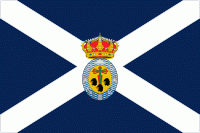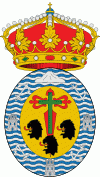Province of Santa Cruz de Tenerife (Provincia de Santa Cruz de Tenerife)
 |
 |
Its capital is the city of Santa Cruz de Tenerife (commonly known as Santa Cruz), on the island of Tenerife (Spain's most populous island ). In 2008 the province had 1,018,510 inhabitants and a density of 313.57 /km2, making it the province of Spain with the sixth highest population density, higher than that of the province of Las Palmas (the eastern half of the Canary Islands). 24% live in the capital. Santa Cruz de Tenerife is the capital of the Autonomous Community of the Canary Islands. There are 54 municipalities in the province; see List of municipalities in Santa Cruz de Tenerife. Tenerife is the most populated island of the Canary Islands and most populous island of Spain. The island of Tenerife has the highest altitude of Spain (Teide 3718 m).
Earlier issued vehicle license plates in this province bear the first two letters "TF" (named after Tenerife). Nowadays the plates share the same numbering system as in mainland Spain.
This province was established in 1927, when the Canarias province (with Santa Cruz de Tenerife as the capital city) was divided into two provinces: Las Palmas and the province of Santa Cruz de Tenerife. In 1982, both provinces became part of the newly founded autonomous community of the Canary Islands.
Map - Province of Santa Cruz de Tenerife (Provincia de Santa Cruz de Tenerife)
Map
Country - Spain
 |
 |
| Flag of Spain | |
Anatomically modern humans first arrived in the Iberian Peninsula around 42,000 years ago. The ancient Iberian and Celtic tribes, along with other pre-Roman peoples, dwelled the territory maintaining contacts with foreign Mediterranean cultures. The Roman conquest and colonization of the peninsula (Hispania) ensued, bringing the Romanization of the population. Receding of Western Roman imperial authority ushered in the migration of different non-Roman peoples from Central and Northern Europe with the Visigoths as the dominant power in the peninsula by the fifth century. In the early eighth century, most of the peninsula was conquered by the Umayyad Caliphate, and during early Islamic rule, Al-Andalus became a dominant peninsular power centered in Córdoba. Several Christian kingdoms emerged in Northern Iberia, chief among them León, Castile, Aragon, Portugal, and Navarre made an intermittent southward military expansion, known as Reconquista, repelling the Islamic rule in Iberia, which culminated with the Christian seizure of the Emirate of Granada in 1492. Jews and Muslims were forced to choose between conversion to Catholicism or expulsion, and eventually the converts were expelled through different royal decrees.
Currency / Language
| ISO | Currency | Symbol | Significant figures |
|---|---|---|---|
| EUR | Euro | € | 2 |
| ISO | Language |
|---|---|
| EU | Basque language |
| CA | Catalan language |
| GL | Galician language |
| OC | Occitan language |
| ES | Spanish language |





































